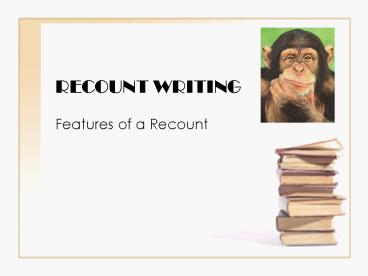RECOUNT WRITING - PowerPoint PPT Presentation
1 / 8
Title:
RECOUNT WRITING
Description:
1) Personal Recounts Recounting an experience in which the author ... biographies, autobiographies, newspaper reports of events, histories, letters, diaries, ... – PowerPoint PPT presentation
Number of Views:1931
Avg rating:3.0/5.0
Title: RECOUNT WRITING
1
RECOUNT WRITING
- Features of a Recount
2
(No Transcript)
3
PURPOSE
- The Purpose of a recount is to tell something
thats happened .This may involve the authors
personal interpretation of events. - FOCUS
- Sequential specific events
4
TYPES
- There are different types of recounts
- 1) Personal Recounts Recounting an experience
in which the author has been directly involved. - 2) Factual Recounts Retelling an event or
incident such as a newspaper report, or accident
report - 3) Imaginative recounts Taking on a fictitious
role and relating imaginary events, e.g. a day in
the life of a pencil.
5
Examples
- Recounts may be in the form of
- biographies,
- autobiographies,
- newspaper reports of events,
- histories,
- letters,
- diaries,
- journals,
- eye-witness accounts of incidents,
- accounts of accidents submitted for insurance
claims.
6
Text Organization
- Recounts generally begin with a Setting or
Orientation that includes background information
to assist the readers understanding of the
recount. There are usually details about Who?
When? Where? Why? - Important Events are then elaborated and usually
arranged in chronological order, first to last.
The events are presented in an interesting way
and may include personal comments - Many recounts have a concluding statement talking
about the authors personal feelings.
7
Language Features
- Includes specific participants (my family)
- Usually written in simple past tense
- Use of dynamic or acting verbs (e.g. went, saw,
fed, returned, etc.) - Use of linking words to do with time provides the
cohesive ties in the text (e.g. Yesterday, when,
after, before, during, later on, meanwhile,
following, etc.)
8
Features (Continued)
- Use of first person personal pronouns I/We
- Details are selected to add interest
- Personal responses to the event may be included
(except in factual recounts)































